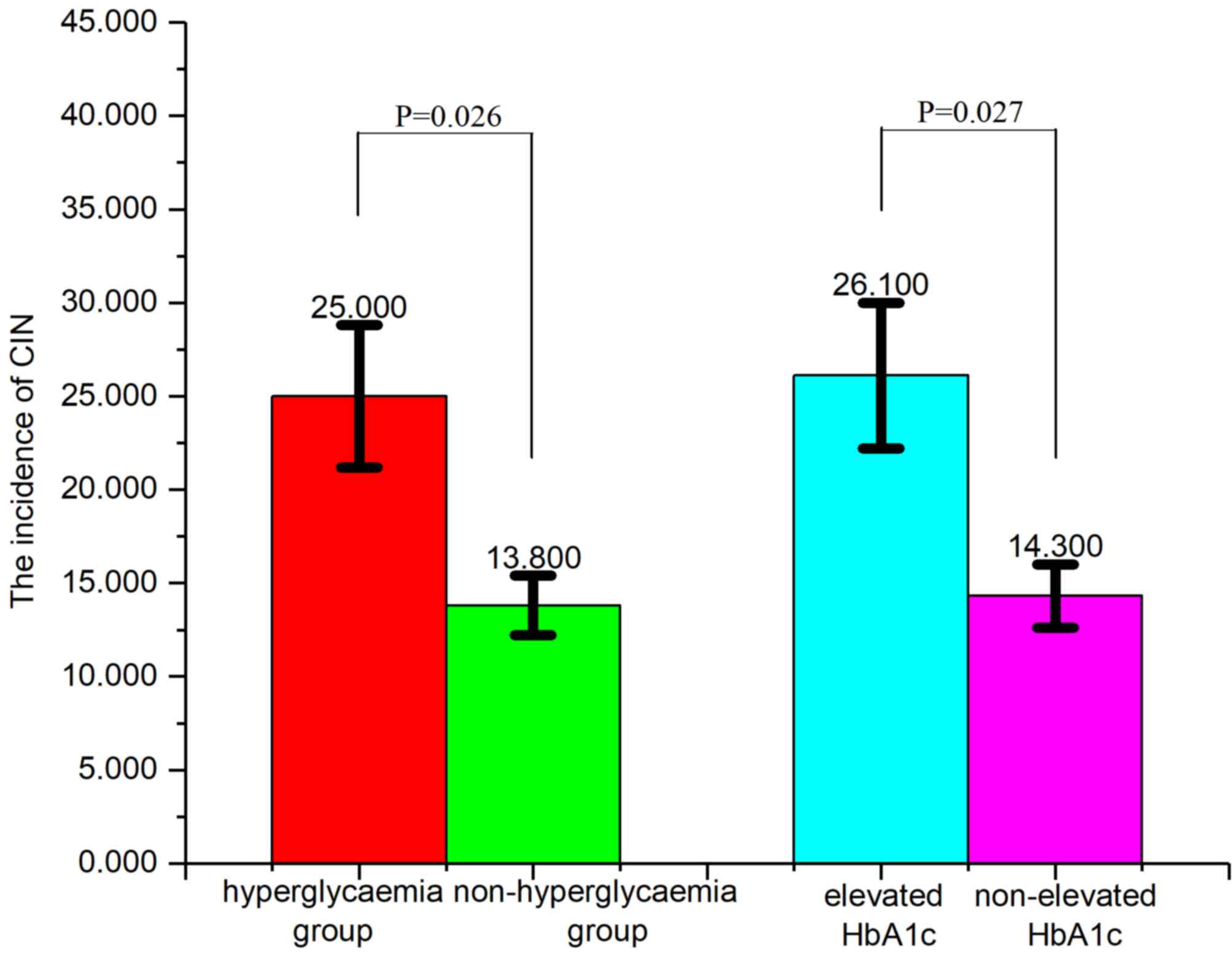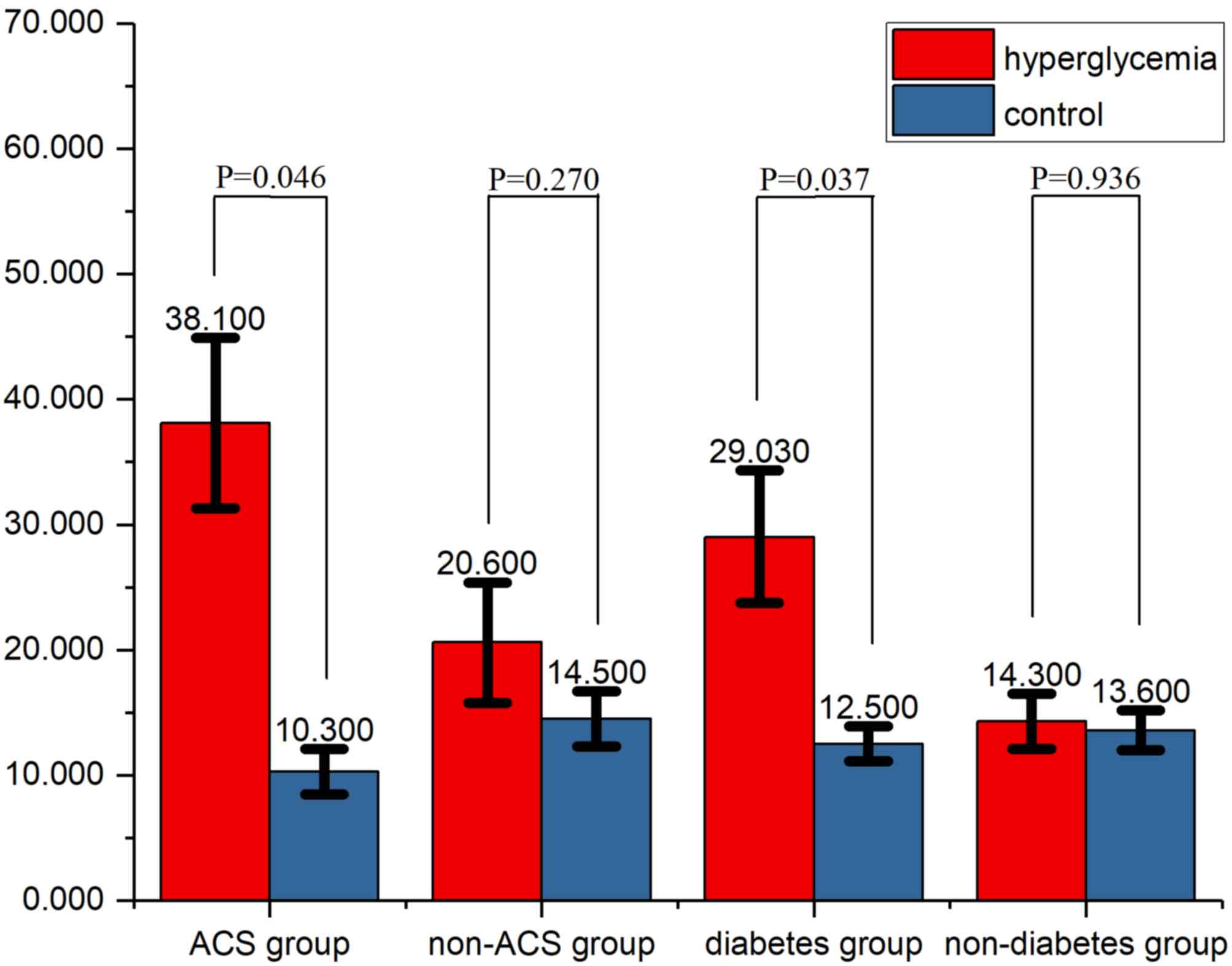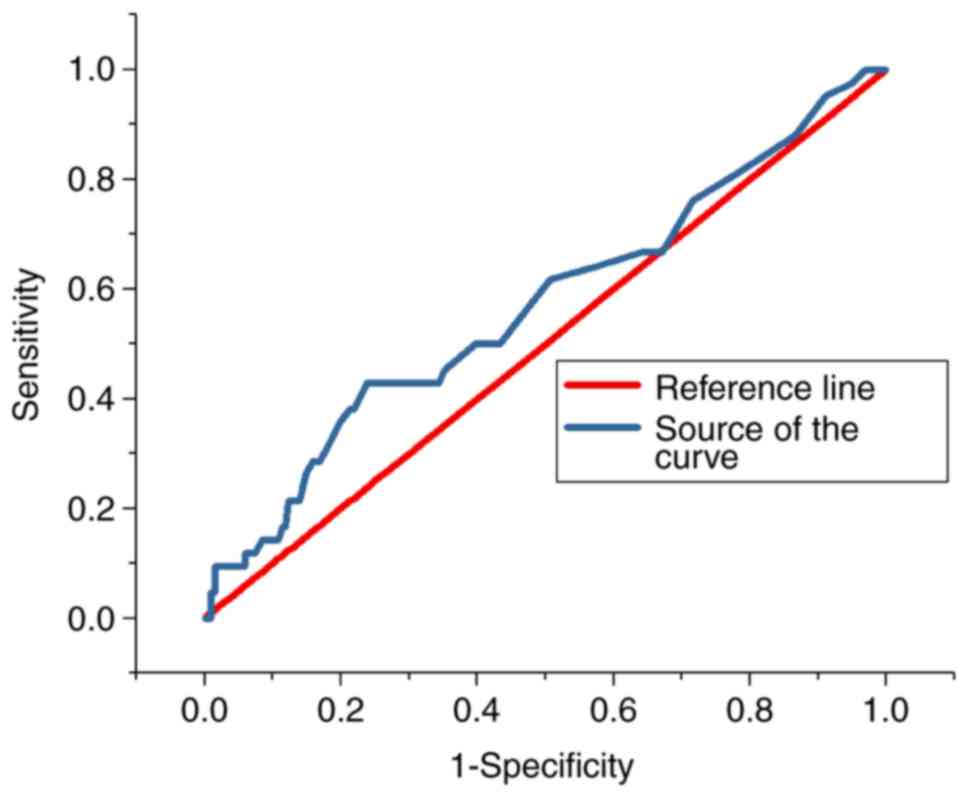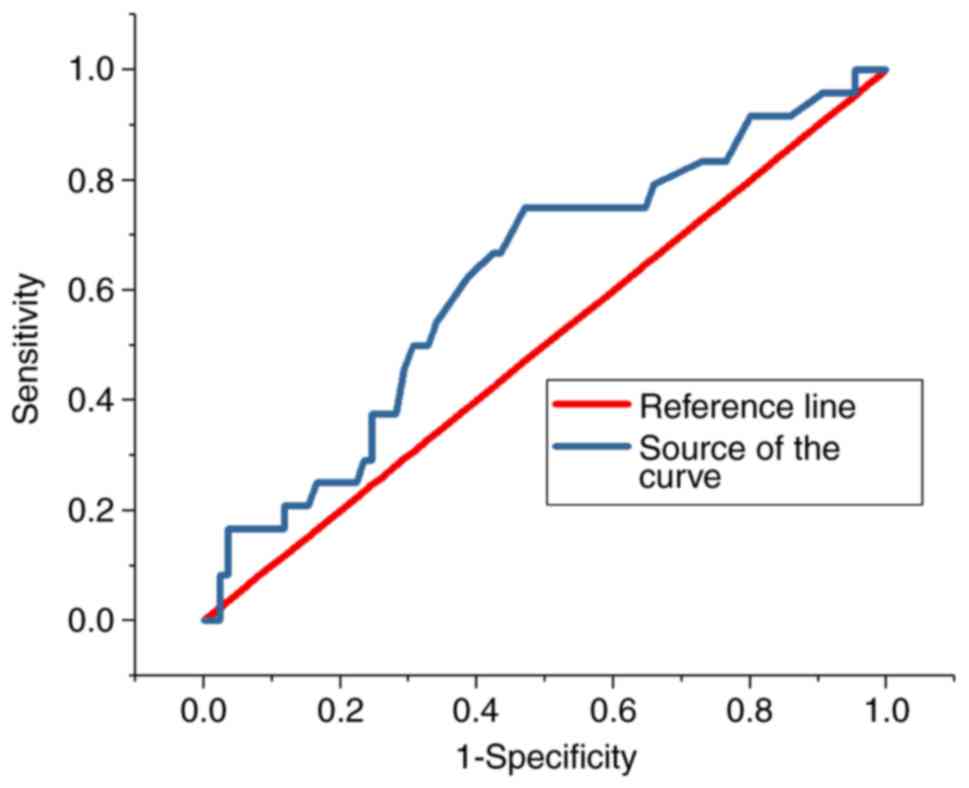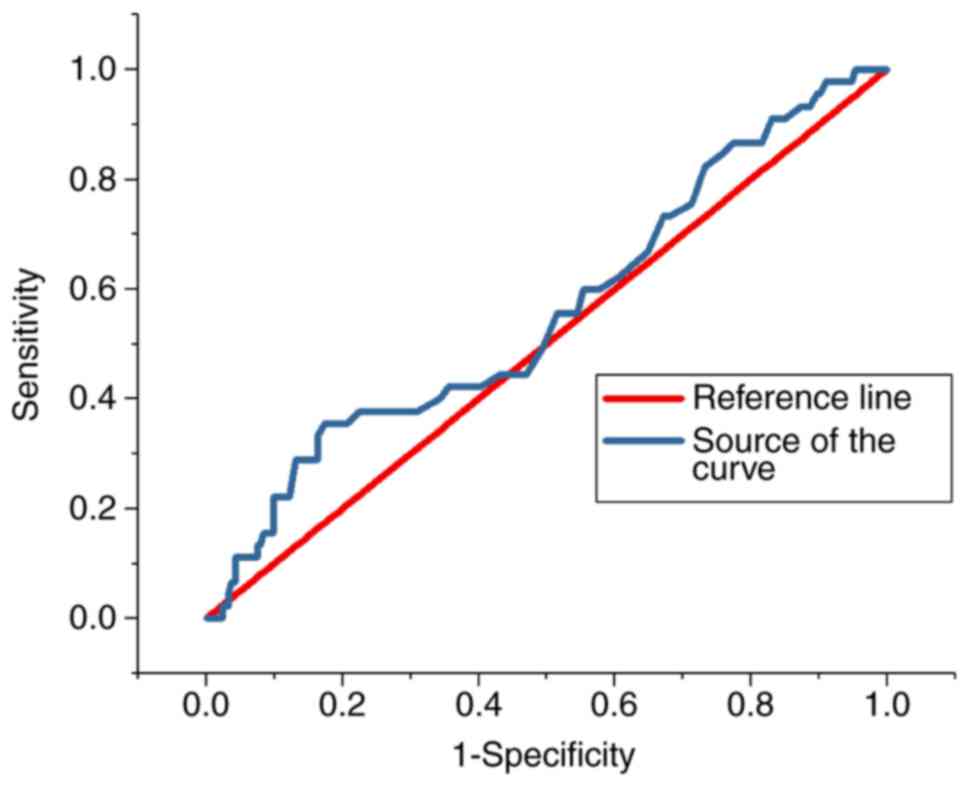|
1
|
James MT, Samuel SM, Manning MA, Tonelli
M, Ghali WA, Faris P, Knudtson ML, Pannu N and Hemmelgarn BR:
Contrast-induced acute kidney injury and risk of adverse clinical
outcomes after coronary angiography: A systematic review and
meta-analysis. Circ Cardiovasc Interv. 6:37–43. 2013. View Article : Google Scholar : PubMed/NCBI
|
|
2
|
Goyal A, Mehta SR, Gerstein HC, Díaz R,
Afzal R, Xavier D, Zhu J, Pais P, Lisheng L, Kazmi KA, et al:
Glucose levels compared with diabetes history in the risk
assessment of patients with acute myocardial infarction. Am Heart
J. 157:763–770. 2009. View Article : Google Scholar : PubMed/NCBI
|
|
3
|
Marenzi G, De Metrio M, Rubino M, Lauri G,
Cavallero A, Assanelli E, Grazi M, Moltrasio M, Marana I,
Campodonico J, et al: Acute hyperglycemia and contrast-induced
nephropathy in primary percutaneous coronary intervention. Am Heart
J. 160:1170–1177. 2010. View Article : Google Scholar : PubMed/NCBI
|
|
4
|
Stolker JM, McCullough PA, Rao S, Inzucchi
SE, Spertus JA, Maddox TM, Masoudi FA, Xiao L and Kosiborod M:
Pre-procedural glucose levels and the risk for contrast-induced
acute kidney injury in patients undergoing coronary angiography. J
Am Coll Cardiol. 55:1433–1440. 2010. View Article : Google Scholar : PubMed/NCBI
|
|
5
|
Perkan A, Cinquetti M, Giannini F,
Santangelo S, Pirozzi F, Barbati G, Vitrella G, Rakar S, Salvi A
and Sinagra G: Admission hyperglycemia and contrast induced
nephropathy. Eur Heart J. 34:555. 2013. View Article : Google Scholar
|
|
6
|
Barbieri L, Verdoia M, Schaffer A,
Cassetti E, Di Giovine G, Marino P, Suryapranata H and De Luca G:
Pre-diabetes and the risk of contrast induced nephropathy in
patients undergoing coronary angiography or percutaneous
intervention. Diabetes Res Clin Pract. 106:458–464. 2014.
View Article : Google Scholar : PubMed/NCBI
|
|
7
|
Dungan KM, Braithwaite SS and Preiser J-C:
Stress hyperglycaemia. Lancet. 373:1798–1807. 2009. View Article : Google Scholar : PubMed/NCBI
|
|
8
|
Levey AS, Stevens LA, Schmid CH, Zhang YL,
Castro AF III, Feldman HI, Kusek JW, Eggers P, Van Lente F, Greene
T, et al: A new equation to estimate glomerular filtration rate.
Ann Intern Med. 150:604–612. 2009. View Article : Google Scholar : PubMed/NCBI
|
|
9
|
Katsiki N, Athyros VG, Karagiannis A and
Mikhailidis DP: Contrast-induced nephropathy: An ‘All or None’
phenomenon? Angiology. 66:508–513. 2015. View Article : Google Scholar : PubMed/NCBI
|
|
10
|
Selvin E, Marinopoulos S, Berkenblit G,
Rami T, Brancati FL, Powe NR and Golden SH: Meta-analysis:
Glycosylated hemoglobin and cardiovascular disease in diabetes
mellitus. Ann Internal Med. 141:421–431. 2004. View Article : Google Scholar
|
|
11
|
Balkau B, Shipley M, Jarrett RJ, Pyorala
K, Pyörälä K, Pyörälä M, Forhan A and Eschwège E: High blood
glucose concentration is a risk factor for mortality in middle-aged
nondiabetic men. 20-year follow-up in the Whitehall Study, the
Paris Prospective Study, and the Helsinki Policemen Study. Diabetes
Care. 21:360–367. 1998. View Article : Google Scholar : PubMed/NCBI
|
|
12
|
Xu Y, Wang L, He J, Bi Y, Li M, Wang T,
Wang L, Jiang Y, Dai M, Lu J, et al: Prevalence and control of
diabetes in Chinese adults. JAMA. 310:948–959. 2013. View Article : Google Scholar : PubMed/NCBI
|
|
13
|
McCullough PA, Wolyn R, Rocher LL, Levin
RN and Oneill WW: Acute renal failure after coronary intervention:
Incidence, risk factors, and relationship to mortality. Am J Med.
103:368–375. 1997. View Article : Google Scholar : PubMed/NCBI
|
|
14
|
Norhammar A, Tenerz Å, Nilsson G, Hamsten
A, Efendíc S, Rydén L and Malmberg K: Glucose metabolism in
patients with acute myocardial infarction and no previous diagnosis
of diabetes mellitus: A prospective study. Lancet. 359:2140–2144.
2002. View Article : Google Scholar : PubMed/NCBI
|
|
15
|
Naruse H, Ishii J, Hashimoto T, Kawai T,
Hattori K, Okumura M, Motoyama S, Matsui S, Tanaka I, Izawa H, et
al: Pre-procedural glucose levels and the risk for contrast-induced
acute kidney injury in patients undergoing emergency coronary
intervention. Circ J. 76:1848–1855. 2012. View Article : Google Scholar : PubMed/NCBI
|
|
16
|
Allison SP, Tomlin PJ and Chamberlain MJ:
Some effects of anaesthesia and surgery on carbohydrate and fat
metabolism. Br J Anaesth. 41:588–593. 1969. View Article : Google Scholar : PubMed/NCBI
|
|
17
|
Shacham Y, Steinvil A and Arbel Y: Acute
kidney injury among ST elevation myocardial infarction patients
treated by primary percutaneous coronary intervention: A
multifactorial entity. J Nephrol. 29:169–174. 2016. View Article : Google Scholar : PubMed/NCBI
|
|
18
|
Park KW, Koo BK, Kim HL, Kim YS, Jo SH,
Lee HY, Kang HJ, Cho YS, Chung WY, Yeon TJ, et al: The incidence
and predictors of contrast-induced nephropathy in adequately
hydrated elderly patients with impaired renal function. Nephrol
Dial Transplant. 22:1794–1795. 2007. View Article : Google Scholar : PubMed/NCBI
|
|
19
|
Persson PB and Tepel M: Contrast
medium-induced nephropathy: The pathophysiology. Kidney Int Suppl.
S8–S10. 2006. View Article : Google Scholar : PubMed/NCBI
|
|
20
|
O'Donnell DH, Moloney MA, Bouchier-Hayes
DJ and Lee MJ: Contrast-induced nephrotoxicity: Possible
synergistic effect of stress hyperglycemia. AJR Am J Roentgenol.
195:W45–W49. 2010. View Article : Google Scholar : PubMed/NCBI
|
|
21
|
Goldstein DE, Little RR, Lorenz RA, Malone
JI, Nathan DM and Peterson CM: American Diabetes Association: Tests
of glycemia in diabetes. Diabetes Care. 27 Suppl 1:S91–S93. 2004.
View Article : Google Scholar : PubMed/NCBI
|
|
22
|
Chinese Diabetes Society, . China
Guideline For Type 2 Diabetes (2013 Edition). Chin J Diabet
Mellitus. 6:447–498. 2014.(In Chinese).
|
|
23
|
Azzalini L, Spagnoli V and Ly HQ:
Contrast-induced nephropathy: From pathophysiology to preventive
strategies. Can J Cardiol. 32:247–255. 2016. View Article : Google Scholar : PubMed/NCBI
|
|
24
|
Subramaniam RM, Suarez-Cuervo C, Wilson
RF, Turban S, Zhang A, Sherrod C, Aboagye J, Eng J, Choi MJ,
Hutfless S and Bass EB: Effectiveness of prevention strategies for
contrast-induced nephropathy: A systematic review and
meta-analysis. Ann Intern Med. 164:406–416. 2016. View Article : Google Scholar : PubMed/NCBI
|



